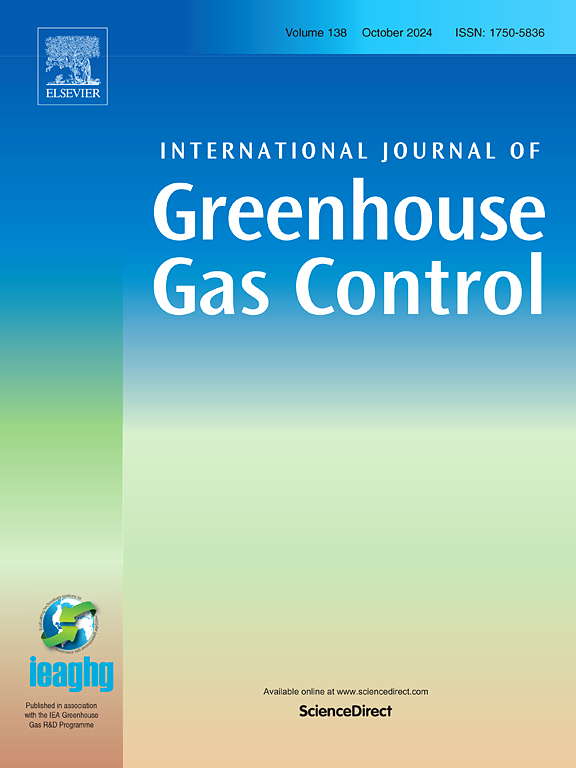Caprock complexity and storage assurance: Advanced findings on CO₂ containment in the Bunter Sandstone Formation
IF 5.2
3区 工程技术
Q2 ENERGY & FUELS
International Journal of Greenhouse Gas Control
Pub Date : 2025-06-20
DOI:10.1016/j.ijggc.2025.104428
引用次数: 0
Abstract
The lower Triassic Bunter Sandstone Formation in the Southern North Sea is a promising site for CO2 storage. This reservoir has a complex structure, particularly in the overlying Haisborough Group caprock, along with fractured shale interlayers, chimney like-structures and fault features. This study highlighted the importance of incorporating all of this complexity into a model of a ‘Bunter-like’ storage site.
Given the limited geological data on Bunter, four scenarios (Cases 1–4) were created to assess the impact of CO2 storage on the integrity of a complex caprock structure. This study revealed that fracture reactivation within variegated shale interlayers differed when comparing scenarios with a multi-layered caprock or a single caprock. With a multi-layered caprock, the CO2 plume was able to leak via the chimney region, whereas, with a single caprock, it did not. Furthermore, mineral dissolution/precipitation behaviour, particularly halite within the sub-layers of the shale interlayers, varied between the multi-layered and single caprock scenarios. Additionally, greater fault reactivation was observed in multi-layered caprocks compared to single caprock scenarios. With a multi-layered caprock, fault reactivation resulted in increased fault vertical and horizontal permeability than those observed in the single caprock scenario. The presence of a fault traversing several different layers of a multi-layer caprock led to different mineralogical behaviour than with a single caprock.
This study emphasized the critical importance of intricate feedback interactions in systems with complex seal and reservoir geologies, as these interactions are essential for governing the overall behaviour of plume migration.
盖层复杂性和存储保障:Bunter砂岩组CO 2遏制的最新发现
北海南部的下三叠统Bunter砂岩组是一个很有前途的二氧化碳储存地点。该储层结构复杂,特别是上覆Haisborough组盖层,具有裂缝性页岩夹层、烟囱状构造和断层特征。这项研究强调了将所有这些复杂性整合到一个“类似邦特”的存储站点模型中的重要性。考虑到Bunter有限的地质数据,我们创建了四种情景(案例1-4)来评估二氧化碳封存对复杂盖层结构完整性的影响。该研究表明,与多层盖层和单层盖层相比,杂化页岩夹层内的裂缝再激活情况有所不同。在多层盖层中,CO2羽流能够通过烟囱区域泄漏,而在单层盖层中则不能。此外,矿物溶解/沉淀行为,特别是页岩夹层亚层内的岩盐,在多层盖层和单一盖层情景中有所不同。此外,与单层盖层相比,在多层盖层中观察到更大的断层再激活。在多层盖层情况下,断层再激活导致断层垂直和水平渗透率比单层盖层情况下高。断层穿过多层盖层的几个不同层的存在导致了与单一盖层不同的矿物学行为。该研究强调了在具有复杂密封和储层地质的系统中复杂反馈相互作用的重要性,因为这些相互作用对于控制羽流迁移的整体行为至关重要。
本文章由计算机程序翻译,如有差异,请以英文原文为准。
求助全文
约1分钟内获得全文
求助全文
来源期刊
CiteScore
9.20
自引率
10.30%
发文量
199
审稿时长
4.8 months
期刊介绍:
The International Journal of Greenhouse Gas Control is a peer reviewed journal focusing on scientific and engineering developments in greenhouse gas control through capture and storage at large stationary emitters in the power sector and in other major resource, manufacturing and production industries. The Journal covers all greenhouse gas emissions within the power and industrial sectors, and comprises both technical and non-technical related literature in one volume. Original research, review and comments papers are included.

 求助内容:
求助内容: 应助结果提醒方式:
应助结果提醒方式:


